The Ancestral Table: Traditional Recipes for a Paleo Lifestyle (27 page)
Read The Ancestral Table: Traditional Recipes for a Paleo Lifestyle Online
Authors: Russ Crandall

3. After 1 hour, toss the peeled and quartered potatoes in a little kosher salt, then add them to the baking sheet; turn them so they are covered in the rendered duck fat. Reduce the oven temperature to 300°F and roast until the thigh meat registers 165°F, about 1 hour 20 minutes. Broil the duck for 1 minute if it doesn’t appear crispy. Remove from the oven and place the duck on a separate baking sheet to rest. Meanwhile, increase the oven temperature to 450°F and roast the potatoes until golden brown, 20-40 minutes. They should be swimming in delicious duck fat at this point; carefully flip the potatoes at the 10-minute mark and again if needed. After the duck has rested for 20 minutes, carve and serve with the potatoes, seasoning with lemon juice and a little salt right before presenting.
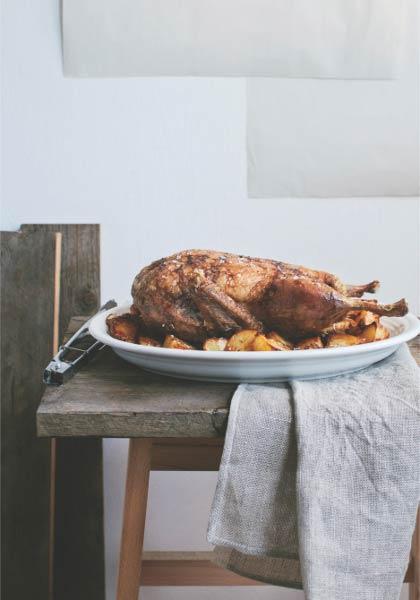
Smoked Turkey Legs
Although smoked turkey legs are largely relegated to theme parks and renaissance fairs today, they have a fairly rich and long-standing history. Turkeys were a product of the New World and became popular in England in the 16th century. Back then, breasts were considered prized cuts of the bird, and legs were left over and sold to the general populace, especially during street fairs. So the tradition was born.
This recipe is similar to the legs you’ll find at fairs today, except that many places soak their turkey legs in sodium nitrate overnight to give them their signature pink color and cured flavor. I don’t have any issues with sodium nitrate in particular (the use of curing salts has been deemed safe by many respected nutritionists), but I find it to be an unnecessary step when cooking at home.
SERVES:
4
PREP TIME:
UP TO 24 HOURS
COOKING TIME:
UP TO 5 HOURS
5 CUPS WATER, DIVIDED
1/2 CUP KOSHER SALT
1/4 CUP HONEY
1 TBSP. PAPRIKA
1/2 TBSP. ONION POWDER
1/2 TBSP. GARLIC POWDER
1/2 TBSP. BLACK PEPPER
1/2 TSP. CAYENNE PEPPER
4 ALLSPICE BERRIES
1 CUP ICE CUBES
4 TURKEY LEGS
1. Bring 3 cups of the water and all the seasonings to a boil, then stir in the remaining 2 cups cold water and ice cubes. Stir until the ice melts to bring the mixture to room temperature, adding more ice if needed. Put the turkey legs in gallon-sized plastic bags, 2 legs per bag, then pour the brine evenly into each bag. Let soak in the brine in the refrigerator overnight.
2. The next day, pour out and discard the brine, then rinse and pat dry the turkey legs. Prepare your grill for indirect smoking using cherry or apple wood (
see here
). Smoke at 245-260°F until the internal temperature reaches 165°F, 3-5 hours. Allow to rest for 5 minutes, then serve.
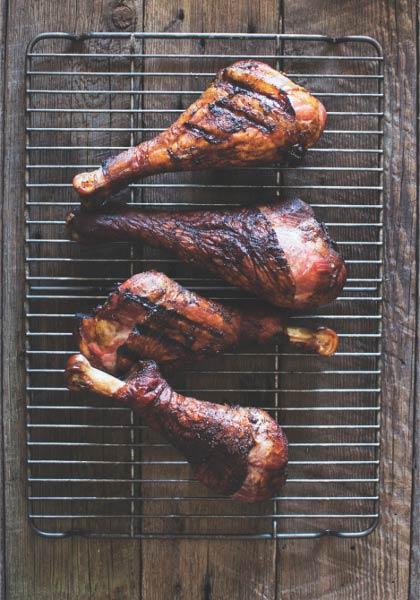
Sephardic Jewish-Style Roasted Eggs
(Huevos Haminados)
This egg dish is popular in Jewish communities in the Middle East and the Mediterranean and is served at Passover Seders (a ritual feast that marks the beginning of Passover). The dish’s Latin-based name might throw you off, but it’s a reflection of its origin in medieval Spain. There are several variations, which include boiling the eggs in onion skins and coffee or simmering them in a slow cooker for several hours. I have found that roasting the eggs directly in the oven is the simplest and most rewarding method.
While the eggshells stay mostly white, the whites become a rich brown color, and the eggs develop a nutty, roasted taste. This cooking method also imparts a hint of meatiness that’s difficult to describe but delicious nonetheless.
SERVES:
4
COOKING TIME:
5 HOURS
8 EGGS
1. Preheat the oven to 220°F, then place the eggs directly on the oven rack and roast for 5 hours. There is no need to rotate the eggs. Some of the whites will make their way through the shells, creating dark spots on the shells, which is fine. Place a sheet of aluminum foil under the eggs in case an egg cracks (which is unlikely).
2. After 5 hours, place the eggs in a bowl of cold water for 5 minutes. Then crack them open and enjoy; the eggs will have shrunk significantly and will be a dream to peel.
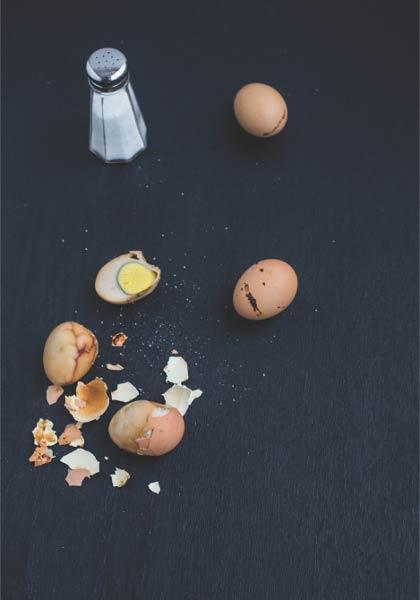
Shakshouka
Shakshouka is a popular North African dish of eggs poached in tomatoes and peppers. Its origin is the subject of debate; some believe that it came from Turkey, where they have a similar dish called menemen, while others believe that it has roots in Yemen. Regardless, Tunisia is generally considered the birthplace of shakshouka as we know it today. Because of its use of eggs, it’s usually served at breakfast, although in Israel it is sometimes served for dinner.
The combination of tomatoes, peppers, and eggs is a naturally tasty union, as evidenced by its prevalence all over the world. In addition to North Africa and the Middle East, the combination is popular in the Americas—the most popular version of all being huevos rancheros.
SERVES:
2
PREP TIME:
10 MINUTES
COOKING TIME:
40 MINUTES
2 TBSP. OLIVE OIL
2 ONIONS, SLICED
2 RED BELL PEPPERS, SLICED LENGTHWISE INTO 1/2" STRIPS
1 TSP. GROUND CUMIN
1 TSP. GROUND CORIANDER
2 BAY LEAVES
2 TBSP. TOMATO PASTE
2 TBSP. HARISSA (
SEE HERE
)
1 (28 OZ.) CAN WHOLE PEELED TOMATOES
4 EGGS
1/2 CUP THICK PLAIN YOGURT
1 SMALL HANDFUL FRESH PARSLEY, CHOPPED
1. Heat the olive oil in a skillet on medium for 1 minute. Add the sliced onions and sauté until softened, about 6 minutes. Add the bell pepper strips and sauté until softened, about 8 minutes, stirring occasionally. Add the cumin, coriander, bay leaves, tomato paste, and harissa and sauté until fragrant, about 2 minutes. Add the tomatoes and simmer until thickened, about 15 minutes, stirring occasionally.
2. When the tomato sauce is ready, crack the eggs on top and cook to your liking. Add a few dollops of yogurt, carefully stir it around to incorporate, garnish with the parsley, then serve with the remaining yogurt.
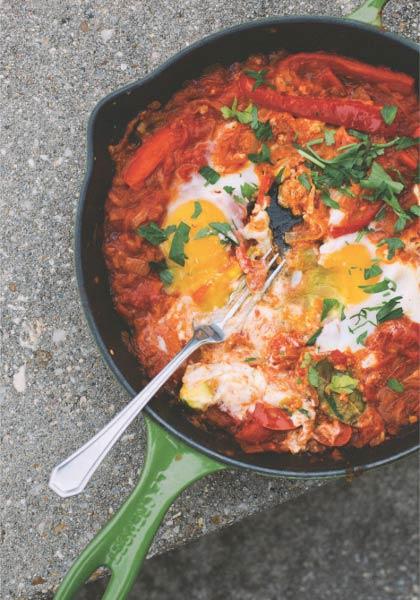
Steamed Eggs
(Gaeran Jim)
I often tire of making eggs in the typical Western style and find steamed eggs to be an excellent change of pace. This recipe is modeled after the Korean preparation of this dish. It’s dead-simple and delicious. In Korea, they often use salted shrimp to bring umami flavors to the dish; I find that fish stock or dashi works well, without having to shop for an extra ingredient.
You can scale the dish to serve more people if you have a larger pot, but the cooking time will probably be a bit longer. The trick is to simmer as gently as possible, which creates an appealing texture and ensures that the bottom doesn’t burn.
SERVES:
2
PREP TIME:
5 MINUTES
COOKING TIME:
10 MINUTES
1/2 CUP FISH STOCK (
SEE HERE
) OR DASHI (PART OF THE NABEMONO RECIPE,
SEE HERE
)
2 EGGS, BEATEN
1/2 TSP. FISH SAUCE
2 GREEN ONIONS, FINELY CHOPPED, DIVIDED
1. If you have an earthenware bowl (ddukbaegi), you can steam the eggs directly over a fire as pictured. If you don’t have an earthenware bowl, you can make this dish in a small pot. Bring the stock or dashi to a boil, then reduce the heat to low until it is barely simmering. As it heats, whisk together the beaten eggs, fish sauce, and all but a few pinches of green onion in a separate bowl. Once the broth is simmering, add the egg mixture to the earthenware bowl and stir for 10 seconds, then cover and steam on low until cooked through, 4-5 minutes. Garnish with the remaining green onions.
2. Alternatively, you can steam the eggs in a water bath for a silkier, custard-like texture. Combine all the ingredients (reserving some green onion) in a heat-safe ceramic bowl, whisk until frothy, and place the bowl in a pot. Fill the pot with hot water until it’s halfway up the bowl, then cover and steam on low until the eggs are cooked through, 10-12 minutes. Carefully remove the bowl and garnish with the remaining green onions.
3. This dish can also be made in a microwave. Combine all the ingredients (reserving some green onion) in a microwave-safe bowl and microwave for 3 minutes. Check for doneness, and microwave for another minute if needed. It won’t be as pretty, but it’ll still taste good. Garnish with the remaining green onions.
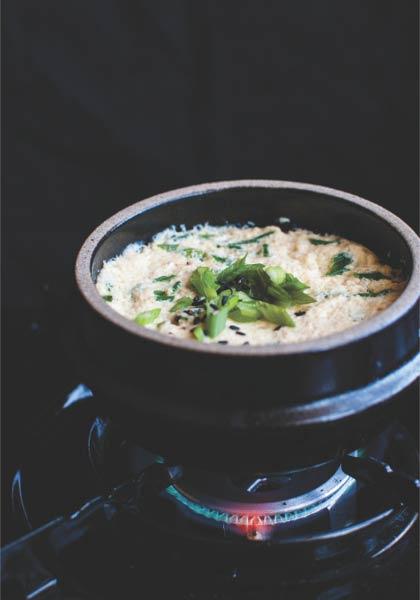
Son-in-Law Eggs
The history behind this dish is frequently debated, but there’s no mistaking the fact that it is a true Thai dish, with its use of tamarind, lime, fish sauce, and hot chiles. It is typically made with soft-boiled eggs, but I find the process of peeling a soft-boiled egg to be no fun. A medium-boiled egg still produces the gooey yolk that’s a signature part of this dish, and peeling is exponentially easier. Bear in mind that older eggs are easier to peel than fresh eggs.
SERVES:
4
PREP TIME:
10 MINUTES
COOKING TIME:
40 MINUTES
2 SHALLOTS
4 TBSP. COCONUT OIL
1 TBSP. TAMARIND PASTE
2 TBSP. HOT WATER
2 TBSP. HONEY